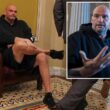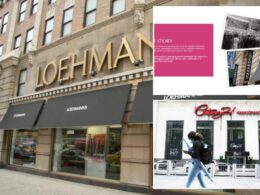In a city where every square foot is precious, Wildflower Studios built up.
Opened in Astoria, Queens, in December 2024, the production hub features 11 sound stages stacked across three floors.
Billed as the world’s first ever “vertical film studio,” it’s a state-of the art, billion-dollar bet on New York City’s entertainment industry, offering a blueprint for how movies and TV series can be made in even the densest urban centers.
The project’s principal developer, Adam Gordon, told NYNext that the most important thing for him and Robert De Niro — a key investor in the project, alongside his Tribeca Film Festival co-founder Jane Rosenthal — “was to create permanent jobs for this incredible industry in New York City … and to create a permanent home for artists to tell their stories.”
“I’ve worked in just about every kind of studio over the years, from classic soundstages to makeshift locations,” said Rosenthal told NY Next. “What’s always been missing in New York is a space designed by creatives for creatives.
Prior to opening the studio, Gordon, a 64-year-old real estate developer, was a relative stranger to the film industry.
His company, also called Wildflower and launched in 2017, was a major player in the self-storage space and critical partner to Amazon — providing the e-commerce giant with warehouse and parking space throughout the metro area.
The e-commerce giant, though, wasn’t the only one interested in his developments.
“People were knocking on our door, seeing if we would rent them space for film productions,” Gordon told NY Next.
So, he went to De Niro — they’re long-time friends, having met through their children — and asked the movie star if he thought there was a “real business” there.
The Manhattan-born actor, famous for his portrayals of New York City characters, had long dreamed of opening a purpose-built studio. Production space in the five boroughs had always lagged behind demand, leaving artists to work in makeshift warehouses or trek to New Jersey, Atlanta and beyond.
The project kicked off in 2019, with De Niro sending Gordon and his son Rafael Gordon, 48 and a Wildflower partner, on a national studio tour — including stops in Los Angeles and Atlanta — to scope out the competition.
“I was shocked by the lack of thought that went into [these spaces],” Gordon said. “We came back with [all of these] ideas, which coalesced into a high performance film studio — efficient, poetic, beautiful and fun.”
The team, headlined by Danish architect Bjarke Ingels — designer of Manhattan’s VIA 57 West and The Spiral — was forensic in designing the space. They conducted dozens of interviews with everyone from teamsters — “no one had ever asked [them their] opinion before,” Gordon said — to A-listers, gathering insight into what would be most useful on set.
Their resulting list of should-haves was encyclopedic.
“It became like a three-dimensional puzzle, packing all of these requirements into the volume,” Ingels told NYNext. “We orchestrated the necessities in such a way that it ends up creating a kind of character … that compression was quintessentially New York.”
From inception to opening, the project took about five years and cost a billion dollars, Gordon said. At 765,000-square-feet, the facilities are so large they even have their own navigation app.
Ingels, who had also seen the “dire conditions” filmmaker friends worked in, chose a raw material palette of galvanized steel and concrete, the humble materials accentuating his cavernous design.
The eleven sound stages — which include cutting-edge augmented- and virtual-reality production spaces — are connected by an internal street, large enough for a box truck, and serviced by an army of elevators, six of which are capable of supporting the size and weight of an elephant.
A truck-sized turntable (inspired by Jay Leno’s garage) helps teamsters maneuver to the loading docks. There’s even a teamsters’ lounge that gives drivers a comfortable place to rest instead of idling outside.
Each stage — the largest is 16,500-square-feet — is a self-contained unit, with adjacent scene shops, dressing rooms (all exactly the same size, so as not to damage egos or trigger contractual issues) and support spaces.
“You don’t have to take a golf cart [because the] carpentry shops are two miles away. Everything is where you need it,” said Gordon, who estimates that Wildflower is enabling productions to be 20% to 30% more efficient.
The studio’s “Hollywood-in-a-box” approach also includes post-production suites, office space and a single commissary staffed by visiting chefs from the James Beard Foundation.
“Filmmaking is a very stressful process sometimes,” Gordon said. “People want to feel taken care of and understood. There’s a lot of psychology in the design here [to achieve that].”
Emmy Park
He also said that Wildflower is “the most sustainable [film studio] in the world.”
The roof holds 150,000 square-feet of solar panels and the building opens up once an hour to let fresh air in and paint gasses out.
Industry discretion precludes him from mentioning who has filmed inside so far, but Gordon will divulge that the very first thing shot inside Wildflower was a scene from season two of “Elsbeth,” CBS’s NYC-based procedural comedy-drama.
Portions of feature films, as well as commercials, have also been shot in the space, he said; at least seven stages will be occupied throughout May.
And the boom hasn’t even yet begun.
Governor Kathy Hochul’s proposed budget, now headed to the legislature for a full vote, includes sizable enhancements to New York’s film tax credit — among them, a $100 million fund for independent productions and a faster payout structure for new applicants. If ratified, the program will last through 2036.
This story is part of NYNext, an indispensable insider insight into the innovations, moonshots and political chess moves that matter most to NYC’s power players (and those who aspire to be).
There will always be filmmaking in New York, but Hochul’s enrichment of the credit framework opens the door for a new class of artists — especially those with smaller budgets — to take advantage of Wildflower and all NYC has to offer.
“Wildflower,” Rosenthal said, “finally gives the city the world-class production home it deserves.”
Send NYNext a tip: nynextlydia@nypost.com








